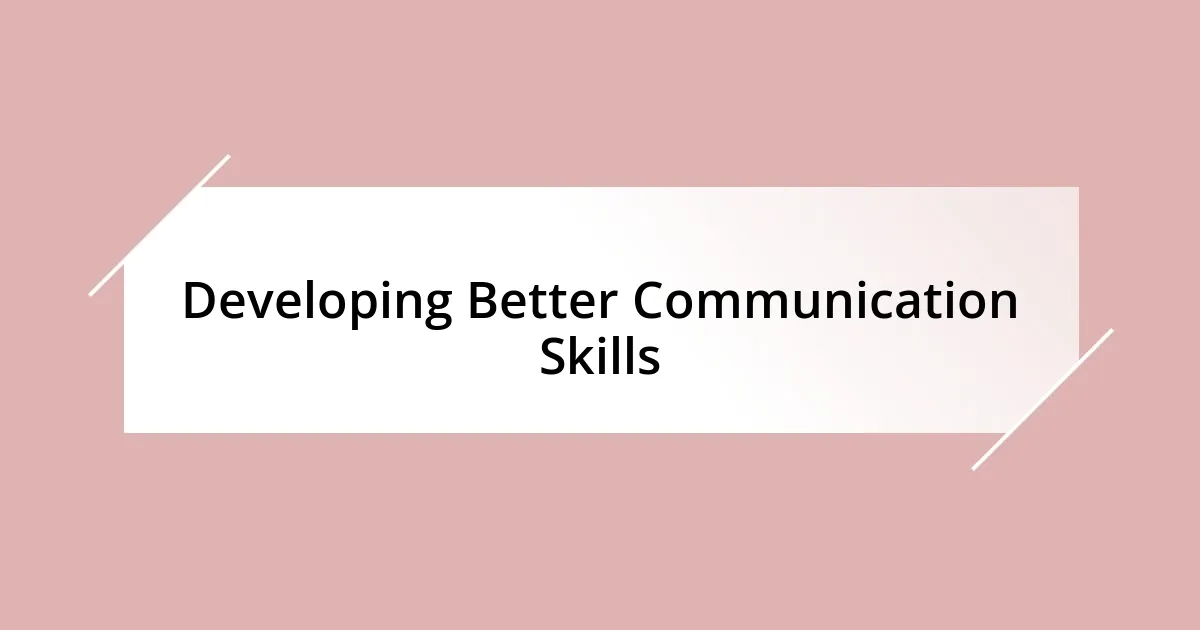Key takeaways:
- Therapy creates a safe space for self-exploration, empowering individuals to untangle emotions and discover personal insights.
- Identifying personal goals in therapy enhances accountability and helps visualize progress towards emotional and mental growth.
- Developing better communication skills, such as using “I” statements and practicing active listening, fosters deeper connections in relationships.
- Maintaining progress after therapy involves integrating learned strategies into daily routines and engaging with a support network for ongoing growth.

Understanding the Purpose of Therapy
Understanding the purpose of therapy can be quite a revelation. I remember when I first sat in that office, I questioned whether talking to a stranger could really help me. What I discovered was that therapy is about creating a safe space to explore emotions and thoughts that often feel overwhelming when faced alone.
Each session became a chance to untangle the knots of my experiences. I learned that therapy isn’t just about fixing problems; it’s about gaining insight into myself. Have you ever felt stuck in your own mind? I eventually realized that voicing my struggles allowed me to see patterns and discover solutions I hadn’t considered before.
Therapy serves as a mirror, reflecting parts of ourselves we might typically ignore. I found it incredibly empowering to recognize my own strengths through a therapist’s guidance. It made me wonder—how often do we overlook our potential while grappling with daily challenges? This process of self-discovery is what truly showcases the purpose of therapy, revealing paths to growth and a deeper understanding of who we really are.

Identifying Personal Goals for Therapy
Identifying personal goals for therapy can be an eye-opening experience. I recall the first time I sat down with my therapist, feeling a bit lost. Together, we worked through what I truly wanted to achieve during our sessions. This wasn’t merely about fixing issues; it was about setting a course for my emotional and mental growth. By pinpointing specific goals, I felt more empowered and accountable on my journey.
Here are some key elements to consider when identifying your personal goals for therapy:
- Clarity: Define what you want to change or understand better.
- Measurable Outcomes: Set goals that allow you to track progress.
- Emotional Awareness: Consider how you want to feel as a result of therapy.
- Long-Term Vision: Think about where you see yourself after therapy.
- Action Steps: Outline practical steps to achieve each goal.
Writing these goals down helped me visualize my path forward, and over time, they became a guiding light in our sessions. It was a relief to transform vague feelings into actionable steps, and I often found myself reflecting on my progress. Each small win became a marker of my growth, reinforcing my commitment to the therapeutic process.

Developing Better Communication Skills
Developing better communication skills was one of the most invaluable lessons I learned during my therapy sessions. Initially, I struggled with expressing my thoughts clearly. Sometimes, I’d find myself talking in circles, unsure how to articulate my feelings effectively. My therapist provided me with tools to simplify my expression. One approach we used involved practicing “I” statements—stating my thoughts and feelings directly, like “I feel overwhelmed when…” This honest expression felt like a weight lifted off my chest. Has anyone else felt that relief from simply stating what’s on their mind?
As I honed my communication skills, I realized the deeper connection it fosters in relationships. I remember a conversation with a close friend where I shared my boundary-setting journey. Instead of shying away from difficult topics, I expressed my needs and feelings assertively. The result? A more genuine conversation that strengthened our bond. I learned that open communication invites vulnerability, allowing others to respond more authentically. Have you experienced that shift when you communicate openly with someone?
Another practical technique we explored was active listening, which is fundamentally about being present and engaged in a conversation. At first, I often found my mind drifting or planning my response instead of truly listening. My therapist guided me in practicing reflective listening, where I repeat back what the other person has said to ensure understanding. This not only deepened my comprehension but also reassured the speaker that their thoughts were valued. It turned out to be a game changer for my interactions, fostering trust and meaningful dialogue.
| Previous Communication Style | Improved Communication Style |
|---|---|
| Avoided expressing feelings | Utilized “I” statements for clarity |
| Shied away from difficult topics | Engaged in open and honest discussions |
| Pretended to listen | Practiced active listening to understand better |

Coping Strategies for Everyday Stress
Coping with everyday stress has been a journey of self-discovery for me. One strategy that has made a significant difference is mindfulness meditation. I vividly remember the first time I set aside just five minutes to sit quietly, focusing on my breath. Initially, it felt awkward. My mind raced with thoughts about the day ahead, but gradually, I found a sense of peace. Has anyone else experienced that moment where the chaos fades away just by being present?
Another technique I found helpful was creating a stress journal. At first, I didn’t think writing down my feelings would help, but I was pleasantly surprised. Every evening, I dedicated a few moments to jotting down my worries and the things that brought me joy. This practice allowed me to process my emotions and reflect on my day. Sometimes, I’d write about frustrations at work, while other days, I’d celebrate small victories. This simple act of writing helped me recognize patterns and triggers, ultimately empowering me to manage stress better.
Lastly, exercise became a crucial outlet for me. I never considered myself athletic, but going for daily walks transformed my mood. While walking, I often listened to uplifting podcasts, and I could feel the weight of stress lifting with each step. It pushed me to reconnect with myself, reminding me of the importance of movement for mental clarity. I’d encourage anyone feeling overwhelmed to find a physical activity they enjoy—how about trying a dance class or simply enjoying nature? You might be surprised at how much better you feel afterward.

Recognizing and Managing Emotions
Recognizing emotions can feel like a daunting task, but I learned to embrace it as a crucial part of my self-awareness journey. There were days when I felt a swirl of emotions, and instead of getting swept away, I started to pause and identify what I was feeling. For instance, the first time I recognized that my irritability stemmed from feeling overwhelmed, it was a powerful revelation. How many times have we reacted to someone without knowing the true emotion behind our response?
In therapy, my therapist introduced me to a technique called “emotional labeling.” This involved taking a moment to name what I was feeling—like claiming, “I feel anxious” or “I feel lonely.” I remember a particularly tough week when I felt an inexplicable heaviness. Once I labeled it as sadness, I could explore its roots, acknowledging the things I was missing in my life. This practice transformed my inner dialogue and provided clarity. Have you tried simply naming your emotions during challenging times?
Managing emotions became my next focus. I learned that it’s not enough to recognize them; they also need a healthy outlet. One of my go-to strategies became physical activity. During moments when emotions felt too intense, I made it a habit to step outside for a quick walk. The fresh air and movement created a space to process my feelings instead of bottling them up. On particularly overwhelming days, I found that even a five-minute stroll could change my perspective significantly. What’s your favorite way to release pent-up feelings?

Building Healthy Relationships
Building healthy relationships is a journey I didn’t fully appreciate until I started unpacking my experiences in therapy. I remember discussing how important communication is—those moments when my partner and I approached tough conversations made a huge difference for us. It was eye-opening to realize that sharing vulnerabilities not only deepens connections but also fosters a safe space for understanding. Have you ever noticed how honesty can transform a difficult dialogue into a moment of growth?
I recall a time when I struggled to express my feelings. I often kept my thoughts bottled up, fearing potential conflict. With my therapist’s guidance, I learned the power of assertiveness—expressing my needs respectfully and clearly. One particular discussion with a close friend about boundaries shifted our entire dynamic for the better. It felt liberating to voice what I needed and realize they appreciated it too. It’s amazing how advocating for yourself can lead to mutual respect and healthier interactions, right?
Another aspect of building relationships involved actively practicing empathy. There were instances where I’d listen to my loved ones but found my mind wandering, missing the essence of their words. Through therapy, I discovered that genuine listening means being fully present, which has changed my approach entirely. I remember a conversation with a family member who was struggling, and as I made the effort to truly hear them, their sense of relief was palpable. It’s a beautiful reminder that sometimes, just being there and listening can strengthen our bonds more than any grand gesture. What steps do you take to ensure you’re fully engaged when someone shares their heart with you?

Maintaining Progress After Therapy
Continuing the progress I’ve made in therapy means integrating what I’ve learned into everyday life. After each session, I found it helpful to jot down key insights or strategies that resonated with me. One afternoon, while sipping my favorite tea, I reflected on how practicing self-compassion transformed my inner dialogue. Instead of berating myself for mistakes, I started saying, “It’s okay to be human.” Have you ever taken a moment to write down your therapy breakthroughs in a journal?
Creating a routine has also been vital in maintaining my progress. I set aside a few minutes each morning for mindfulness meditation, which helps ground me. The other day, I felt the familiar waves of anxiety creep in, but thanks to my practice, I noticed it, breathed through it, and allowed it to pass. It felt empowering, like a reminder that I’m in control of my reactions now. What daily rituals help you stay connected to your mental and emotional well-being?
Finally, reaching out to my support network proved invaluable after therapy. Whether it’s a text to a friend or a chat with a family member, sharing my experiences reinforces my journey. I still remember the day I called a close friend to discuss my growth after therapy—her genuine support reminded me that I’m not alone in this journey. It’s incredibly reassuring to know that vulnerability can foster deeper connections. How do those around you contribute to your healing process?














